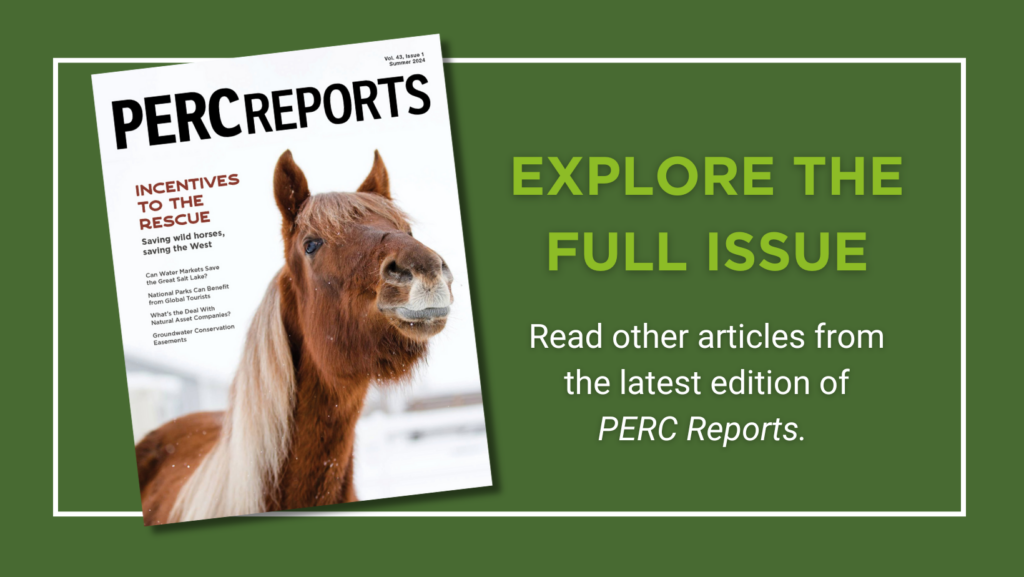
In February, Congressman Bruce Westerman introduced America’s Wildlife Habitat Conservation Act, a bill that would provide $1.6 billion in additional funding for state and tribal wildlife conservation efforts. The bill is similar to the Recovering America’s Wildlife Act, a bill that has already shown bipartisan interest in enhanced funding for state and tribal conservation programs. The habitat conservation bill isn’t just a spending measure, however. It pairs that funding with policy reforms—some of which were inspired by PERC research—that would improve incentives for habitat restoration and wildlife recovery efforts. While we can anticipate much debate on whether the proposed funding is enough, the common-sense policy reforms would allow conservation funding to go further. Here’s how they work.
Greater Incentives to Recover Species
First, the habitat conservation bill includes a section that would improve incentives for states and landowners to recover endangered and threatened species. It directs the U.S. Fish and Wildlife Service, which implements the Endangered Species Act, to issue regulations for threatened species that set incremental recovery targets for the species anGreatd reward states and landowners with regulatory relief as those targets are met, giving them a direct stake in whether the species is improving or declining.
PERC’s research pioneered this idea of designing threatened species rules as roadmaps to recover species, by pairing objective, incremental recovery targets with gradual regulatory relief. It’s an approach that’s been gaining traction with experts and conservationists.
In 2020, the Defenders of Wildlife, the Nature Conservancy, the Environmental Defense Fund, and other conservation groups held a workshop to identify ways to “improve the ESA from a conservation perspective.” The number one priority identified by the group was to “tailor protections” for species through rules “that account for whether a threatened species is improving or declining.” Doing so, they explained, would “provide incentives to landowners to help reduce threats in an effort to move a species into a lower tier with its less stringent protection requirements.”
David Willms with the National Wildlife Federation has also written that this reform “could facilitate faster species recovery, reduce delisting litigation, free resources for use on other vulnerable species, and rebuild support and trust for ESA implementation and state management from those most skeptical of each.”
The habitat conservation bill isn’t just a spending measure. It pairs that funding with policy reforms—some of which were inspired by PERC research—that would improve incentives for habitat restoration and wildlife recovery efforts.
Better incentives to recover endangered and threatened species are urgently needed. Although the Endangered Species Act has proven effective at preventing extinction, we’ve fallen far short of the statute’s ultimate goal of recovering species. This goal has been achieved for only 3 percent of listed species, and far fewer species have recovered than the Fish and Wildlife Service predicted should have by now. The service has also found that the percentage of species improving is in the low single digits.
The Obama and Trump administrations shared a rare point of agreement on how to improve incentives to recover species: reduce regulatory burdens as species progress toward recovery. The Obama administration relaxed regulations as species were upgraded from endangered to threatened more than “nearly every other presidential administration,” according to Defenders of Wildlife.
Building on this policy, the Trump administration eliminated a presumption that threatened species should be regulated the same way as endangered species, effectively codifying the Obama administration’s policy shift. In issuing this reform, the Fish and Wildlife Service explained that it would “incentivize conservation for both endangered species and threatened species” because “landowners and other stakeholders may see more of an incentive to work on recovery actions” if progress toward recovery led to regulatory relief.
If reducing regulations when species improve from endangered to threatened encourages conservation, then continuing to relax regulations as threatened species make further incremental progress toward recovery would provide even more incentives for habitat restoration and recovery efforts. It would also allow states to build trust with conservation groups and local communities by taking on management responsibility gradually while the species remains listed.
Restoring Forests
The habitat conservation bill would also overturn a controversial court decision, known as Cottonwood, that hinders the U.S. Forest Service’s ability to protect and restore wildlife habitat in national forests. When the decision was issued in 2015, the Obama administration urged the Supreme Court to reverse it, explaining that Cottonwood could “cripple the Forest Service.” Nearly 10 years later, that prediction has been borne out. According to the Biden administration, Cottonwood threatens to upend management of 87 national forests while the Forest Service spends “between 5 and 10 years and millions of dollars” on unnecessary paperwork—time, and money the agency doesn’t have when facing a wildfire crisis.
Cottonwood concerns a seemingly technical issue that has a huge real-world impact. The Endangered Species Act requires agencies to rigorously review their proposed actions to ensure that they won’t jeopardize endangered or threatened species. In Cottonwood, a litigation group challenged a Forest Service project intended to reduce wildfire risks near Bozeman, Montana, and, thereby, protect wildlife habitat and the town’s drinking water supply. The project had been thoroughly scrutinized, but the group claimed this wasn’t enough. The project must be stopped, it asserted, because the general forest plan governing the area did not consider critical habitat for the Canada lynx that was not designated until years after the forest plan was completed.
It is inevitable that some circumstances change during the years or decades between when a general plan is adopted and a specific project moves forward. That’s why each project undergoes its own in-depth review. To require the Forest Service to start over every time there’s a new development would be, as Senator Angus King colorfully described it, like redoing a city’s zoning plan every time an issue arises in a single neighborhood. It doesn’t serve conservation. The only people who benefit are litigants who view it as another tool to stop projects.
The Forest Service faces an 80-million-acre backlog in needed forest restoration. Recognizing the threat further delays in this critical work would pose for forest ecosystems and the wildlife that depends on them, conservation groups including PERC, Rocky Mountain Elk Foundation, Backcountry Hunters and Anglers, and many others have urged Congress to fix Cottonwood. Thanks to those efforts, the idea has gained bipartisan support. The habitat conservation bill would finally move it across the finish line.

Restoring Wildlife Reguges
The habitat conservation bill would also grant the Fish and Wildlife Service a “good neighbor authority” allowing it to partner with states, counties, and tribes to restore habitat and improve recreational opportunities on lands administered by the agency. The proposal is modeled on authority that the Bureau of Land Management and the Forest Service have enjoyed for decades, which they’ve used to increase their management capacity, encourage collaboration over conflict, and effectively manage ecosystems and resources that cross federal, state, and private land boundaries.
The model has proven effective. It has allowed dozens of projects to restore national forests to go forward that might otherwise have been delayed due to conflict, a lack of resources, or too little manpower. The habitat conservation bill would give the Fish and Wildlife Service the same flexibility to manage areas critical to endangered and threatened species, migratory birds, and other wildlife.
Incentivizing Habitat Conservation
Finally, the habitat conservation bill codifies several existing Fish and Wildlife Service policies that have helped encourage voluntary species recovery efforts on private lands. These include “Candidate Conservation Agreements with Assurances,” a type of agreement the Fish and Wildlife Service created to encourage conservation efforts for species being considered for listing under the Endangered Species Act. In exchange for these early efforts, the service provides a degree of certainty to participants about the regulations they’ll face if the species is listed. Codifying this process would remove any legal uncertainty around these agreements.
The bill would also require the service to maintain confidentiality about the presence of listed species on private land. Landowners have long expressed concern that publicizing the presence of species on their land would open them up to litigation or other risks. As a result, many landowners refuse access to their land for scientists to study species and their habitats, limiting our knowledge of how well species are doing and what recovery efforts work. To help this problem, the service and several states have used confidentiality guarantees to encourage landowner cooperation. The bill would remove any doubt about the service’s authority to do so.
Conclusion
While more funding can help conserve species, if used in the right ways, money alone isn’t enough. By removing regulatory barriers and improving incentives for proactive habitat restoration and other recovery efforts, the policy reforms proposed in the habitat conservation bill could make a big difference for endangered and threatened wildlife. Amidst so much posturing and conflict over wildlife policy, this bill is a substantive and serious solution that addresses real conservation challenges.




